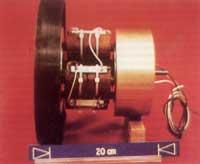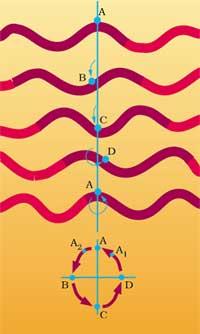Piezomagnetic motor
We know that the temperature change has long elongated and contracted solids. For example, the iron rings of the carriage wheel, once they have been placed after opening them heated and after contracting them cooled, have been pressed and glued to the wood. Also in mechanics, to fit certain parts with tightening adjustment, it first heats and expands, then cools and shrinks remaining fixed fitted.

In these solids, dilations and contractions are not only produced by changing the temperature. Even by changing the electric current of the solid or the magnetic field, its dimensions are modified, causing enormous forces in it. A great advantage of these dimensional changes is that, unlike what happens in thermal expansion, they occur quickly in a small second. Heating and cooling the carriage wheel ring cannot be changed in size for example twenty times, but by changing the electric or magnetic field. Thanks to this, the metal part exerts a great force in the opening and shrinkage, although the size of the amplitude or change of dimension is very small.
The fact that the amplitude is very small has so far been the main obstacle, so the first engines that use these effects have recently appeared, namely the sound transducers.
Evolution of magnetostrication
In this type of effect the first exploitation has been piezoelectricity. When the electric current passes through the interior, some crystals (for example, quartz) are stretched one side and the other contracts, without varying the volume. However, it is produced on average, that is, by the pressure or elongation of the glass is generated electric current. This phenomenon was discovered by Mr. Curie in 1880.
Magnetostriction, whose linear effect is known as piezomagnetism, was discovered in 1837. To the elements that can be magnetized as iron, nickel or cobalt, when in variable magnetic field the dimensions change. As with the electric current, the volume does not vary, except for areas of very high intensity.
Using alternating currents there are two variable fields: the variable electric field and the variable magnetic field it generates. The piezoelectric and piezomagnetic effects come together, leading to periodic dimensional changes or vibrations. This effect has been used to emit sound waves, especially for underwater detection.
Piezomagnetism was used in the last World War, but it was slowly abandoned for the benefit of piezoelectricity. Thanks to the ceramics he was able to provide greater powers. On the other hand, the electric current is more manageable than the magnetic field, so the magnetostriction was left out.
In the 1960s, some features of rare earth were discovered and samariums, terbios, disprosions and other chemical elements were observed to produce large-scale piezomagnetic effects. (The bar of the iron meter, for example, in large magnetic fields stretches two hundredths of a millimeter and the bar of the meter of alloys more or less a hundred times) For this they needed very low temperatures. However, as has been seen, alloying these elements with iron, the effects of magnetostriction of great amplitude were obtained at room temperature, but for this purpose magnetic fields of great intensity were needed.
Subsequently, in 1974, the Naval Ordnance Laboratory of North America obtained an alloy of terbium, disprosion and iron of three elements (Terfenol-D), for using magnetic fields easily accessible by electromagnets. The metro bar is 2.4 mm long, allowing its operation in the classic mechanisms.


Current magnetostriction
From there, many applications to magnetostrication have been found. Valid for sound transducers, engines, valves, diesel engine injectors, etc.
Application studies have focused mainly on the United States and Japan, but also on European laboratories are concerned about the phenomenon. In fact, there is material for large amplitude magnetostriction. Comparatively, if the aluminum meter bar is heated from 0 to 100 (C) it stretches 2.4 mm, and the Terfenol-D material meter bar stretches the same.
However, his strength is not negligible. The piezoelectric forces are between 10 and 20 times greater than the magnetic forces of attraction that act in conventional motors and serbomechanisms, and between 20 and 50 times the piezomagnetic forces. The piezomagnetic forces resemble those of thermal expansion, about 25,000 N/cm 2. That means the square bar of thick centimeters would lift a mass of 2.5 tons! Also, do not forget that this force is very fast.
Applications of piezomagnetism
An application of this effect is the obtaining of mechanical vibrations of great power from alternating currents. Between 3 and 10 times more effect than what has been achieved so far with piezoelectricity, it can be produced in acoustic transducers by piezomagnetism, that is, in special speakers of simple sound and intensity. They are mainly used for underwater detection. In fact, the displacement of water is much more complicated than the displacement of air and strong acoustic emitters are needed to oscillate large liquid masses in deep water. The lower the frequency of the waves, the more useful is the magnetostriction to perform this type of sonars.
This great oscillation force, however, can be used in other applications: solenoid valves, springs of controlled elasticity, injecting needles of diesel engines and, in general, in any mechanism that requires a reduced displacement and a great force.
Piezoelectric motor

Therefore, one of the most interesting applications is to convert vibration into circular motion. In this case the turn will be very slow, but the torque is very large. An obstacle in classic electric motors is that at low speeds there is also a small moment. However, it is much higher than the more thermal engine (which works with piston or turbine), in which at low angular speeds (when rotating very slowly) is almost zero.
When in practice a low speed and a great torque is required, it is necessary to interlace gear reducers or transmission of high pressure hydraulic motors. This is visible on many construction machines.
The vibration itself is a fast motion of low amplitude forward, and the transformation into turning motion has its problems. The crank/crank mechanism is used to convert the linear movement into a spinning movement, but miniaturization has not been achieved from a certain size. Therefore, in Japan several houses (NEC, Hitachi, Shinsei, etc.) have manufactured engines with piezoelectric ceramic rings.
The piezoelectric ceramic ring begins to oscillate due to the alternating current. Each point of the ring describes the ellipse (see figure) and there seems to be a spinning wave in the ring. On it turns the dish that touches the ring, powered by that wave.
Today, piezoelectric motors are used for cleaning the front glass in the zoomes of camophones (Japan), watches (Switzerland) or automobiles (Germany). Do not forget that piezoelectric motors can also be linear.
Piezomagnetic motor
A piezomagnetic motor has also been developed in Germany. This time the movement occurs like caterpillars. We support, stretch and grab with the front legs. Then the hind legs are released, they contract and the cycle is resumed supporting them later.
Magnetostrication produces enormous forces of low displacement. The mechanism resembles a pair of disc brakes attached to the Terfenol bar. The operation is shown in the attached figure.
The mechanism can be applied to the circle or straight piece. Turn motor or linear motor can be obtained. In addition, since the forces generated by magnetostriction are very large, depending on whether or not the current is sent can be motor or brake. This does not occur in conventional engines. This is because once the current has been stopped, they do not put obstacles to the movement, and in some cases (for example, so that it does not fall once the load rises and stops) it is necessary to put compact and similar mechanisms. The presence of very low turning speeds in piezomagnetic motors allows its use as a positioner in machine tools.
The turn is not continuous but discontinuous. Therefore, the engine can stay at the desired time, with the axle fixed at the same point.
On the other hand, in magnetostrication, the response time is less than that of one thousandth of the second and some researchers want to use it to compensate for the deformations of heavy material, eliminate harmful vibrations, etc.





